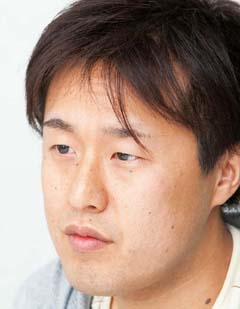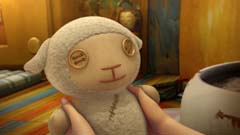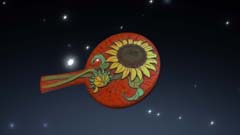Interview with Naoyoshi Shiotani (3)
 | Naoyoshi Shiotani Born in 1977, Shiotani is one of Japan's most promising young animation creators. His early works include TV series Windy Tales (key animation supervisor, 2004) and Blood+ (2005), for which he also directed the kaleidoscopic third opening film, Colors of the Heart (check our special feature here), selected in competition for the 11th Holland Animation Film Festival. His directorial debut, Tokyo Marble Chocolate (2007) was awarded with the Grand Prize in the Feature Films Section of SICAF 2008. Shiotani joined the staff of Production I.G's first 3DCG animated feature film, Oblivion Island: Haruka and the Magic Mirror as storyboard artist an animation director, but also contributed the island design concept and designed Cotton, the sheep-shaped plush doll that belongs to the protagonist, Haruka. |
PART 3
You mentioned that you designed Cotton, which appears to be a key character to the movie. Can you tell us what inspired you in creating this lovely sheep doll?
Cotton is the stuffed animal everybody has had when he/she was a kid. I wanted everyone in the audience to relate with and overlap his/her own personal childhood memories the very instant Cotton appears on screen. His role in the movie is the answer to the question, if a toy could be given the opportunity to move and talk, what would he say?
Cotton is a neglected childhood treasure who has the chance to meet up again with his owner, the very person that left him lying around and eventually forgot him. To the movie's main theme extent, Cotton is one of the most emblematic characters of the story.

Animation director, storyboard artist, character designer, art concept designer... anything else?
Oh, well, if I really have to mention it... I also contributed the details for several objects appearing in the movie, but one object I designed from the very beginning was Haruka's mirror. You may notice two sunflowers decorating the mirror. In the language of flowers, sunflower stands for "I'm always with you," which is obviously connected with the role of Haruka's mother in the film. Incidentally, I used the sunflower image in Tokyo Marble Chocolate, too. I'm wondering how many people noticed it, though...

How about Haruka? What kind of design did you aim for, and what challenges did you face?
Creating Haruka was perhaps the most difficult task in this project. We wanted a convincing modern Japanese high-school girl, but we needed to find the right balance between realism and animation style. We wanted her to be cute but not a stunning beauty. We wanted the cuteness typical of Japanese 2D animation, but we had to translate it as to fit into a 3DCGI movie. I had the designer come up with literally hundreds of ideas, and choosing among them was like a sort of movie audition. I have to add that for the final Haruka, we also received the precious contribution of Kazuchika Kise, one of I.G's veteran animators, who also happens to be my mentor. As you see, even if you work in 3D, the experience of 2D animators is invaluable.
The relationship between Haruka and her father appears to be central to the movie.
As the title (Hottarake no Shima) suggests, this movie revolves around the concept of hottarake, that in English you may translate in different ways, from neglect to abandon to forget, not because of malice but because of unintentional carelessness. This concept does not necessarily refer to something tangible. As it is said in the film, we abandon even our memories without realizing it. This movie tells that we should care more about feelings. We should never forget what is really important for us and the people around us, and it is something you can't see or grab with your hands.
The movie does not tell what happened to little Haruka after her mother dies, but we can easily imagine a lot when we see 16-year-old Haruka take her frustration out of her workaholic father in a never-ending arguing on everything.
I have no direct experience of other countries, but in many Japanese families there's not enough time for proper communications between parents and children, because we all are apparently too busy in doing something else. Members of the same family have difficulty in understand each other because communication, or the time necessary for it, is being neglected.
I'd be happy if, after watching the film, people would stop for a while and think about their parents, then go home and start to communicate over dinner or any other occasion.
(3 - to be continued)
© 2009 FUJI TELEVISION NETWORK / Production I.G / DENTSU / PONY CANYON

![WORK LIST[DETAILS]](/contents/works/design/images/left_title.gif)



 terms of use
terms of use